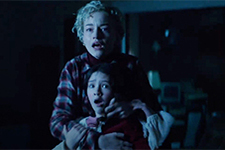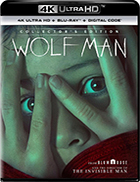Wolf Man (4K UHD)
|  It is ironic that Universal is about to open a massive new addition to their already sprawling Florida theme park based around the stable of classic monsters that first brought the studio to prominence in the early 1930s. The immensity of the theme park construction stands in stark contrast to the purposefully minimalist approach that writer/director Leigh Whannell has taken to Wolf Man, Universal’s most recent attempt to jump-start their classic monster movie franchise, which has seen several ups and downs since the initial failure of the Tom Cruise-driven The Mummy (2017) eight years ago. If the theme park is driven primarily by the “go big or go home” ethos, Whannell appears to want to strip the genre down to its bare dramatic essence, leaving behind enormous Gothic manors, deep-dark family histories, and supernatural shenanigans in favor of something more akin to a chamber drama—with teeth and claws. Of course, even the werewolf of the title isn’t exactly what you expect it to be because there is no supernatural backstory of lycanthropy or a family curse or any of the things you typically expect in this terrain. Rather, Whannell and Corbett Tuck, his wife and co-screenwriter, reimagine werewolfism as something more akin to a virus, a sickness that is tragically and horribly passed on from one person to the next through a scratch or bite. That is the typical means of transmitting the curse in werewolf stories, but the emphasis on contagion and the complete lack of references to anything that might be considered supernatural reorients the story in a completely different way, giving it an unsettling post-COVID vibe. Whannel’s film is set almost entirely in the deep forests of northern Oregon (although it was shot in New Zealand). The story begins with a tense prologue featuring the protagonist, Blake, as a young adolescent (played by Zac Chandler), out hunting with his stern father, Grady (Sam Jaeger). There is clearly something out there in the woods, and Blake’s father is obsessed with finding it just as he is terrified of it hurting Blake. We then fast-forward 30 years where we find Blake (Christopher Abbott) living in San Francisco with his journalist wife Charlotte (Julia Garner) and their adolescent daughter, Ginger (Matilda Firth). Blake is out of work and playing house husband when he receives news that his father, from whom he has become estranged and who had disappeared some years ago, has been declared legally dead, thus giving him ownership of the house and land where he grew up. Blake is determined to return to his homestead after having been gone for years, so he, Charlotte, and Ginger pack up in a rented truck and head north. To say that things do not go well would be an understatement, as the return to the dark woods puts Blake and his family—which is already teetering on collapse—in the very danger from which he father had tried to protect him all those years ago. After getting lost in the dense forest, they meet up with a man named Grady (Sam Jaeger), who Blake knew years ago and who plays the role of the slightly sinister local who seems to know a lot. After things go awry and Blake is scratched by the just off-screen monstrosity, the film becomes a focused drama about an already stressed family dealing in the dark with daddy slowly turning into a wolf. And, while I can see what Whannell, who previously co-wrote and directed the latest take on The Invisible Man (2020), is trying to do and I applaud his choice to go against the grain, the film itself simply does not bear out his ambitions. Part of the problem is that the family at the center of the narrative is too vaguely and quickly sketched for us; we have little time with them before they are off to the forest, so the transformation of Blake and the disintegration of his family doesn’t carry the kind of weight it is clearly meant to. Whannell is right to focus on the slow progress of the “sickness” that essentially steals Blake away from his family, thus putting the dramatic focus on Charlotte, the grieving wife and mother forced into survival mode, and Ginger, who is traumatized by what is happening to her daddy. The film’s heavy reliance on practical effects is often quite amazing and gives us more of a classical sense of Cronenbergian body-horror rather than the thrill of sudden, elaborate transformation, and Whannell has a great sense of how to suggest horrors lying just out of sight, the best being the beast’s hot breath rising above the edge of a tree-house fort. Those moments stand out, but mostly because the film as a whole feels slightly lacking, never quite making good on its various promises.
Copyright © 2025 James Kendrick Thoughts? E-mail James Kendrick All images copyright © Universal Studios | |||||||||||||||||||||||||||||
Overall Rating: 

 (2.5)
(2.5)


